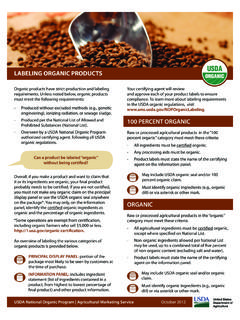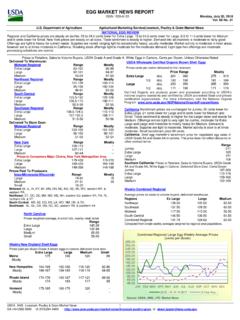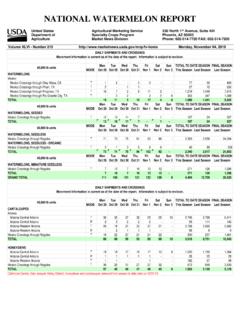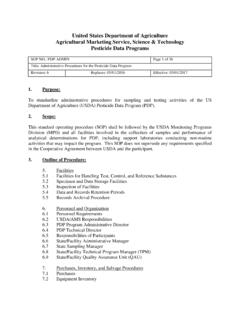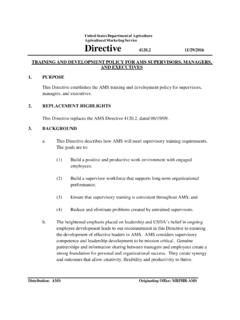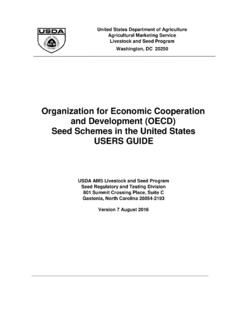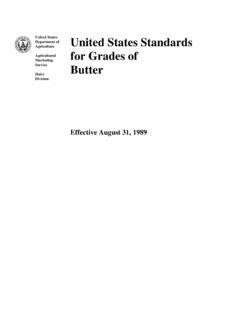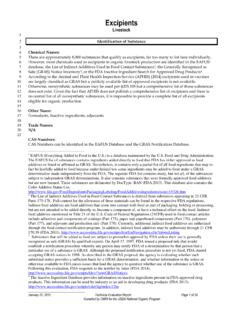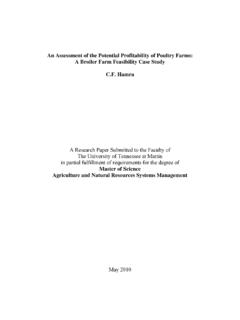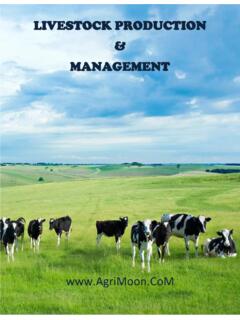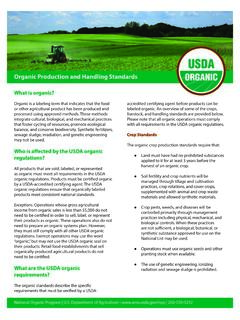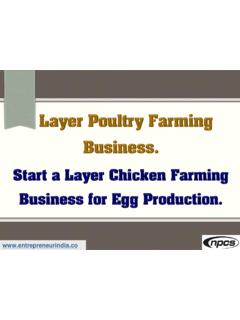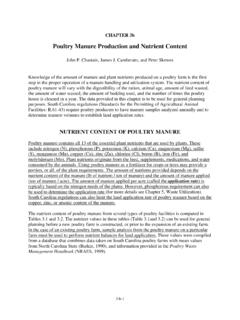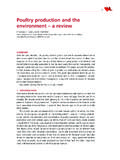Transcription of Poultry - Guidelines
1 Guidelines for organic Certification of Poultry Written and designed by staff at the Northeast organic Farming Association of Vermont. This product was developed with support from Department of Agriculture s Agricultural Marketing Service, National organic Program The following Guidelines are based on the USDA organic regulations (7 CFR 205). In order to be eligible for organic certification, farms must be in compliance with the following standards. Land Requirements ( ) Land used for pasturing and housing livestock and livestock feed and bedding crops must qualify for organic certification. The organic regulations state that any field or farm parcel, from which harvested crops are intended to be sold as organic , must have had no prohibited substances applied to it for a period of three years immediately preceding the harvest of the crop.
2 Example to determine if a field qualifies: A farmer's last fertilizer application is on May 31, 2011. On May 31, 2012 first transitional year has ended. On May 31, 2013 second transitional has ended. On May 31, 2014 third transitional year has ended. This means after May 31, 2014 pastures or crops harvested can be certified organic . Please refer to the Guidelines for organic Certification of Crops for a complete description of the organic standards for crops. Origin of Livestock ( ) Poultry intended for slaughter or egg production must be under continuous organic management beginning no later than the second day of life.
3 Accepted Day old chicks purchased from a conventional hatchery Poultry over one day old purchased from certified organic sources Prohibited Purchase of chicks from a conventional hatchery that have not been managed organically from the second day of life All purchases of organic birds must be accompanied with copies of organic certificates as well as receipts indicating the seller s name, date and number of birds purchased. Written and designed by staff at the Northeast organic Farming Association of Vermont. This product was developed with support from Department of Agriculture s Agricultural Marketing Service, National organic Program Livestock Feed ( ) All certified animals must receive 100% certified organic feed.
4 All pastures must also be certified organic . If roughages are used as bedding, they must also be certified. Accepted for feed 100% of feed (grains and forages), feed supplements, and/or feed additives, including pastures, that are organically produced, handled and certified under the NOP regulations. Water additives (electrolytes, molasses, cider vinegar, etc.) consistent with the National List Minerals and vitamins that are FDA approved or currently listed in AAFCO will be considered for approval by your organic certifier. You must keep receipts and accompanying certificates as documentation of off-farm feed purchases.
5 The receipt must verify the quantity and source of feed purchased from off-farm. All non- organic certified feed supplements, including minerals, must be approved by your certifier. Antibiotics, GMO derived products, animal by-products and synthetic preservatives are not permitted in any feed products. Be sure that any mineral/feed supplements do not contain prohibited ingredients (such as mineral oil). Agricultural substances in feed supplements (molasses, soy oil, etc.) must be certified organic . Prohibited Use of animal drugs, including hormones, to promote growth Urea or manure added to feed or in feed formulas. Direct fed mammalian or Poultry by-products such as animal fats and rendered products (does not include fishmeal).
6 Providing feed supplements or additives in amounts over what is needed by the livestock for nutrition and health. Kitchen and garden scraps that are not certified organic . Contact your certifier for a list of dealers who offer organic feed in your area. Livestock Health Care ( ) Animal health is the result of preventative and on-going management efforts to create living soils, provide nourishing forage and feed, and improve the quality of livestock life. Animals must be kept in healthy, low stress environments. Producers must use preventative health care practices and may only use approved treatments. Accepted Selecting species and types of livestock suitable to the conditions on their farm and resistant to prevalent diseases and parasites Providing feed sufficient to meet the needs of the animals, including vitamins, minerals, protein and/or amino acids, fatty acids, energy sources, and fiber Establishing appropriate housing, pasture, and sanitation to reduce diseases, parasites and predation Written and designed by staff at the Northeast organic Farming Association of Vermont.
7 This product was developed with support from Department of Agriculture s Agricultural Marketing Service, National organic Program Providing animals with the opportunity for exercise, freedom of movement, and reduction of stress Administering preventative vaccines and other veterinary biologics Performing physical alterations when needed for the animal s welfare, taking care to minimize pain and stress. Prohibited Withholding medical treatment from a sick animal to maintain organic status Administering any animal drug in the absence of illness Use hormones for promotion of growth of livestock Selling, labeling, or representing as organic any animal or animal product that has been treated with antibiotics, a synthetic substance not on the National List, or any prohibited non-synthetic substance Livestock Living Conditions ( ) Housing must provide for adequate ventilation, adequate supply of clean water and proper sanitation.
8 Housing must provide access to the outdoors, shade, shelter, exercise areas, fresh air and direct sunlight year round. Housing must also provide adequate protection from predators. Accepted Temporary confinement from the outdoors due to inclement weather; the animal s stage of production ; conditions under which the health and safety of the animal could be jeopardized; risk to soil or water quality; preventative healthcare procedures or the treatment of illness or injury; breeding; and 4-H or other youth projects. Prohibited Animals confined in such a way that prevents lying down, standing up, fully extending limbs and moving about freely.
9 Inadequate clean, dry bedding. If the bedding qualifies as roughage (hay, straw, etc.), it must comply with the feed requirements and be certified organic . Continuous total indoor confinement of any animal. Lumber treated with arsenate or other prohibited substances may not be used for new construction that will come into direct contact with soil or livestock. For example, treated wood should not be used to construct brooder housing or portable pens where Poultry can have direct contact with the wood. Soil Erosion and Water Quality ( ) A producer must select tillage and cultivation and grazing practices that maintain or improve the physical, chemical and biological condition of the soil and minimize erosion.
10 Manure must be managed in a manner that does not contribute to contamination of crops, soil or water, by plant nutrients, heavy metals, or pathogenic organisms and optimizes the recycling of nutrients. Written and designed by staff at the Northeast organic Farming Association of Vermont. This product was developed with support from Department of Agriculture s Agricultural Marketing Service, National organic Program Egg and Carcass Washes ( ) Due to the porous nature of egg shells, egg cleaners are considered to be food additives and must be on the National List of allowed non-agricultural substances. Water used in direct post-harvest contact for egg or carcass washing is permitted to contain chlorine materials at levels approved by the Food and Drug Administration or the Environmental Protection Agency for such purpose.
